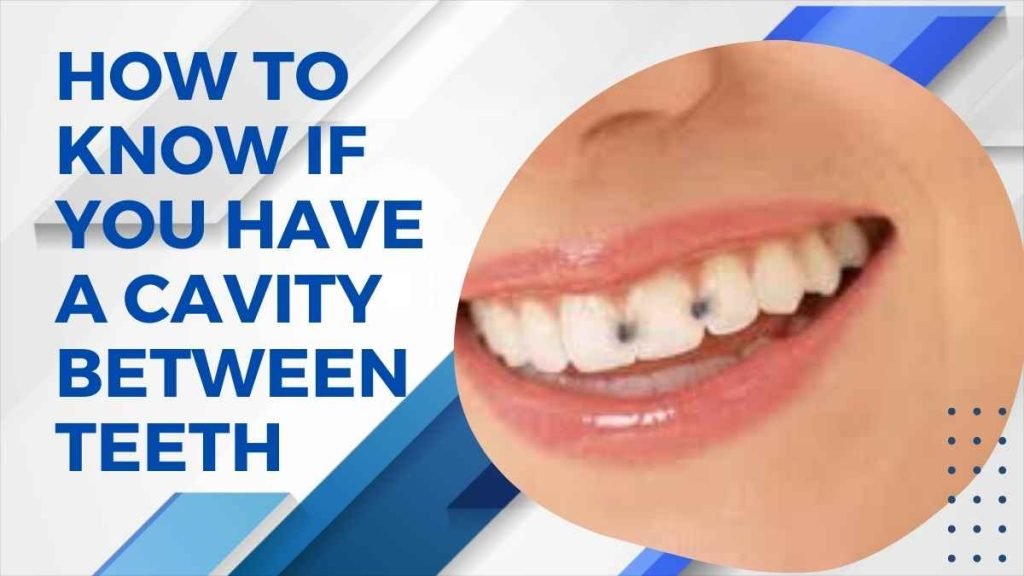How to Know If You Have a Cavity Between Teeth! Welcome, dear reader, to a journey of dental discovery! Have you ever wondered if that persistent toothache might be due to a cavity hiding between your teeth? Fear not, for in this comprehensive guide, we will explore How to Know If You Have a Cavity Between Teeth. Here we will unravel the mysteries of interproximal cavities. From understanding what a cavity is to recognizing the signs and symptoms, we will walk you through the process step by step. So, put on your dental detective hat, and let’s dive in!
Table of Contents
What Is a Cavity?
Before we delve into the nitty-gritty of detecting interproximal cavities, let’s understand what a cavity really is. In simple terms, a cavity is a hole or damaged area in a tooth caused by tooth decay. Tooth decay occurs when the bacteria in your mouth produce acids that erode the enamel, creating a cavity. These cavities can occur on any surface of the tooth, including in between teeth, which are known as interproximal cavities.
How to Know If You Have a Cavity Between Teeth: A Step-by-Step Guide
Here you can checkout the step-by-step guide about How to Know If You Have a Cavity Between Teeth:
Total Time: 10 minutes
Regular Dental Checkups Are Key
The foundation of good oral health is regular dental checkups. Dentists are trained to spot even the tiniest of cavities using specialized tools and X-rays. Scheduling biannual appointments can help in early detection.
Pain or Discomfort While Eating
Do you experience sharp pain or discomfort when biting down on certain foods? This could be a sign of an interproximal cavity. The pressure from chewing can exacerbate the pain.
Increased Sensitivity to Hot and Cold
If you wince at the thought of hot soup or cold ice cream, it might be more than just sensitive teeth. Sensitivity to hot and cold temperatures can indicate a cavity, especially one nestled between your teeth.
Visible Dark Spots or Holes
Grab a mirror and take a close look at your teeth. Dark spots or visible holes are telltale signs of cavities. If you spot anything unusual, it’s time to visit your dentist.
Flossing Difficulties
Flossing shouldn’t be painful or result in bleeding gums. If you find it difficult to floss between certain teeth or notice bleeding, it could be due to an interproximal cavity making the area tender.
Signs and Symptoms of a Cavity Between the Teeth
Interproximal cavities often exhibit specific signs and symptoms that set them apart from cavities on other tooth surfaces:
Foul Breath (Halitosis)
Bacteria thriving in cavities emit an unpleasant odor. If you notice persistent bad breath despite maintaining oral hygiene, an interproximal cavity might be the culprit.
Unpleasant Taste
A strange or lingering bad taste in your mouth can indicate a cavity. Decay often produces a metallic or bitter taste, disrupting your sense of taste and smell.
Gum Sensitivity and Swelling
Cavities between teeth can irritate the gums, leading to sensitivity and swelling. If your gums appear red and inflamed, it’s time for a dental checkup.
Pus Around the Tooth
In advanced stages, interproximal cavities can lead to the formation of pus around the affected tooth. This is a clear sign of infection and warrants immediate dental attention.

Effective Treatments for Interproximal Cavities
Dental Fillings
Dental fillings are the most common treatment for cavities. The decayed portion of the tooth is removed, and the cavity is filled with materials such as amalgam or composite resin, restoring the tooth’s function and appearance.
Inlays and Onlays
In cases where the cavity is too large for a filling but not extensive enough to require a crown, inlays and onlays are used. These are custom-made restorations that fit into or onto the tooth, providing a durable solution.
Root Canal Therapy
If the cavity has reached the pulp (the innermost part of the tooth containing nerves and blood vessels), a root canal procedure might be necessary. During this treatment, the infected pulp is removed, and the tooth is sealed to prevent further infection.
Common Mistakes to Avoid
Understanding cavities is crucial, but avoiding common mistakes can prevent them from occurring:
Poor Oral Hygiene: Neglecting regular brushing and flossing allows plaque and bacteria to thrive, leading to cavities. Maintain a consistent oral hygiene routine to keep your teeth healthy.
Excessive Sugar Consumption: Sugary foods and drinks feed the bacteria in your mouth, accelerating tooth decay. Limit your sugar intake and opt for healthier alternatives.
Delaying Dental Checkups: Postponing dental visits allows cavities to worsen. Regular checkups enable early detection and timely intervention.
Tips and Tricks
Prevention is the best cure. Here are some tips to keep your teeth cavity-free:
Proper Brushing Technique: Use fluoride toothpaste and brush your teeth at least twice a day. Pay attention to each tooth surface and brush for at least two minutes.
Floss Daily: Flossing removes food particles and plaque from between your teeth and along the gumline. Make it a daily habit to maintain oral health.
Mouthwash and Fluoride Treatment: Rinse your mouth with an antimicrobial mouthwash to kill bacteria. Additionally, consider fluoride treatments to strengthen your enamel, making it more resistant to decay.
Facts About Interproximal Cavities
Unraveling the mysteries of interproximal cavities:
Silent Offenders: Interproximal cavities can develop without causing noticeable symptoms, making regular dental checkups even more crucial.
Genetics Play a Role: Some individuals are genetically predisposed to cavities. If your parents had a history of tooth decay, you might be at a higher risk.
Baby Teeth Are Not Immune: Contrary to popular belief, baby teeth are susceptible to cavities. Early dental care is essential for children to maintain good oral health.
Conclusion
In conclusion of How to Know If You Have a Cavity Between Teeth, you’ve reached the end of our dental detective journey! Armed with knowledge, you can now recognize the signs of interproximal cavities and take proactive steps to maintain your oral health. Remember, regular dental checkups, proper oral hygiene, and a balanced diet are your allies in the battle against cavities. Keep smiling, keep shining, and most importantly, keep those teeth healthy! Here you can checkout that How to Get Pearly White Teeth.
FAQs About How to Know If You Have a Cavity Between Teeth
Can interproximal cavities heal on their own?
No, cavities cannot heal on their own. Once a cavity forms, it requires dental treatment to prevent it from worsening.
Are interproximal cavities common?
Yes, interproximal cavities are common, especially in areas where food particles tend to get trapped between teeth.
Can interproximal cavities cause tooth loss?
If left untreated, interproximal cavities can lead to tooth loss. Decay weakens the tooth structure, making it vulnerable to fractures and infections.
Is it possible to prevent interproximal cavities entirely?
While you can reduce the risk, it’s challenging to prevent cavities entirely. Regular dental checkups, proper oral hygiene, and a balanced diet significantly lower the risk.
Does the type of toothbrush matter in preventing cavities?
Yes, the type of toothbrush matters. Dentists often recommend using a soft-bristled brush to prevent enamel damage and to reach the crevices between teeth effectively.
How often should I replace my toothbrush?
It’s recommended to replace your toothbrush every three to four months or sooner if the bristles appear frayed. A worn-out toothbrush is less effective at cleaning your teeth.
Can interproximal cavities cause bad breath?
Yes, interproximal cavities can cause bad breath. Bacteria in the cavities produce foul-smelling gases, leading to persistent bad breath.


